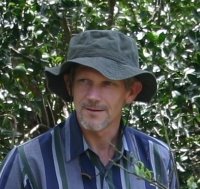I have to say I'm a little sheepish about having lived in Mbale, in the shadow of Mount Elgon for almost 12 years, but not having set foot inside Mt Elgon national park until last Saturday (still haven't made it to any of the peaks, or into the caldera, the largest in the world, BTW). Nathanael, Jonathan, their friend Abraham and I loaded ourselves and our binoculars, water, and bug repellent into the pickup and left the house shortly after 7:30 Saturday morning.
It took us a couple of hours to get up the first two terraces of Mt Elgon and to the park gate, partly because we made a couple of stops along the way. One of them, about 20 km from Mbale town, was a rare and memorable occasion. I pulled over to take a closer look at a medium-sized bird of prey sharing the top of a muvuli tree with a hamerkop (Scopus umbretta). To our great delight the raptor turned out to be a peregrine falcon (Falco peregrinus). It stayed put and gave us excellent views from right under the tree from which it was taking in the morning.
Once inside the park, we hooked up with a young guide and did a 5-km circuit that took us through mostly secondary forest. There were, however, quite a number of enormous remnant giant trees from the days before the primary forest was encroached and before the park was gazetted with its current boundaries (formerly quite a number of local villagers living near the forest boundaries had cut down many of the larger trees and done some cultivation inside the park perimeter). On our way we stopped by a lovely little waterfall and a cave with a considerable bat population (the latter especially fascinating to the boys).
Our time was somewhat limited, so we hiked at about double the ideal birding pace. This limited the number of bird species that we were able to observe/identify, but still we came across several notables, including some new ones for me (I'll mark these with a double asterisk).
** montane oriole (Oriolus percivali)
** both banded / brown-throated and black-throated wattle-eyes (Platysteira cyanea and P. peltata)
** black-throated apalis (Apalis jacksoni)
** Luehder's bush-shrike (Laniarius luehderi)
** male white-phase paradise flycatcher (Terpsiphone viridis)
** African hill-babbler (Illadopsis abyssinica)
** white-tailed crested flycatcher (Elminia albonotata) -- this is an old friend with which I first became familiar in one of my favorite spots on the planet, Zomba mountain in Malawi; I'd not seen it before in Uganda
** black-faced rufous warbler (Bathmocercus rufus) -- heard these secretive birds but did not get a glimpse of them; they are familiar from many times birding in rainforest near Kakamega, Kenya
